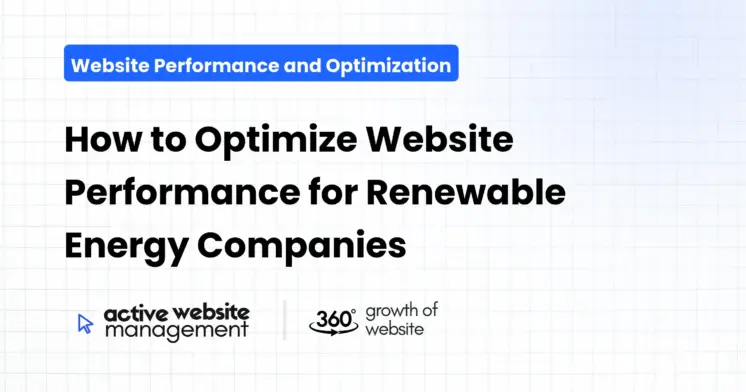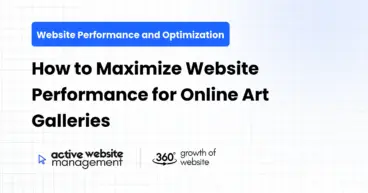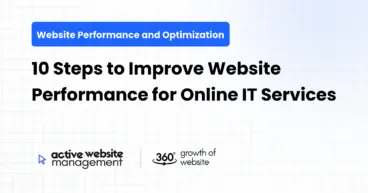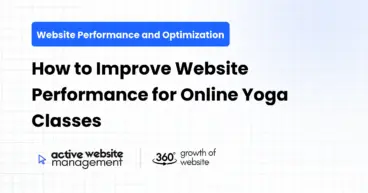February 3, 2025
14 min read
The renewable energy sector is booming, and with that surge comes the need for websites that can keep pace. A slow, clunky website can be the equivalent of a flickering light in a solar panel field—inefficient and off-putting. For companies dedicated to sustainability and green tech, website performance isn’t just about speed; it’s about reflecting your brand values. This comprehensive guide will illuminate how to optimize your website for peak performance, attracting more customers and solidifying your position as a leader in the renewable energy space. Let’s dive into how we can turn your website into a powerhouse of lead generation and information dissemination.
Imagine a potential client, excited about installing solar panels, clicks on your website. They’re met with a spinning wheel, images that take an eternity to load, and a generally frustrating experience. This isn’t just inconvenient; it’s a lost opportunity. Here’s why website performance is crucial for renewable energy companies:
First Impressions are Lasting Impressions
Your website is often the first interaction a potential client has with your brand. A slow website signals inefficiency, which is the antithesis of the clean, efficient energy solutions you offer. A fast, well-designed website, on the other hand, builds trust and credibility. It tells customers, “We care about quality, and that extends to every aspect of our business.”
Search Engine Optimization (SEO) and Visibility
Google loves fast websites, and search engines will penalize slow ones. Speed is a ranking factor, meaning a slow site will be buried in search results, making it harder for potential clients to find you. Improving your site’s speed will boost your SEO, increasing your visibility and driving organic traffic.
Don’t Just Maintain Your Website—
Grow It using Active Website Management! Don't Wait for Growth—Accelerate It with Active Website Management
User Experience (UX) is King
People expect seamless, lightning-fast experiences online. A slow website leads to frustration, higher bounce rates (people leaving your site quickly), and fewer conversions. A smooth, responsive website means users will stay longer, engage more, and are more likely to contact you for services. A poor user experience can tarnish your brand image faster than you can say “renewable energy.”
Mobile-First World
Most people browse the web on their phones. If your website isn’t optimized for mobile, you’re losing out on a significant chunk of your audience. Mobile optimization includes speed, responsiveness, and ease of navigation on smaller screens. A sluggish mobile experience is a surefire way to lose potential clients.
Conversions and Lead Generation
Ultimately, the goal of your website is to generate leads and drive conversions. A faster website encourages users to explore more of your content, making them more likely to fill out a contact form or request a quote. Speed directly impacts your bottom line.
In short, optimizing your website isn’t just a technical necessity; it’s a strategic move to capture more leads, build your brand, and establish yourself as a leader in the renewable energy sector.
The Pillars of Website Optimization
Optimizing a website isn’t about doing just one thing; it’s about a holistic approach that tackles several critical areas. These are the pillars upon which a fast, efficient website stands:
1. Image Optimization
Images are essential for visually communicating your work, whether it’s showcasing a solar panel installation, a wind turbine farm, or a satisfied customer using your products. However, large image files can significantly slow down your website.
How to Optimize Images:
- File Format: Use WebP format, when possible, for superior compression and quality. Otherwise, JPEG is best for photographs, and PNG is good for graphics. Avoid BMP or TIFF.
- Compression: Compress your images before uploading them to your website. Tools like TinyPNG, ImageOptim, and ShortPixel can compress images without losing too much quality.
- Resizing: Resize images to the exact dimensions they’ll be displayed on your website. Don’t upload a 3000px wide image if it only needs to be 600px wide.
- Lazy Loading: Implement lazy loading, which only loads images as they are scrolled into view. This drastically improves initial page load times.
- Descriptive File Names: Use descriptive file names that include relevant keywords. For instance, “solar-panel-installation-roof.jpg” is much better than “image123.jpg”.
- Alt Text: Add descriptive alt text to all images. This improves accessibility and helps search engines understand what the image is about.
2. Code Optimization
The code that makes up your website can be a source of bloat, making it slow and inefficient. Streamlining your code can have a massive impact on your site’s speed.
How to Optimize Code:
- Minification: Minify your HTML, CSS, and JavaScript files. Minification removes unnecessary characters (whitespace, comments) from your code, reducing file size.
- Combine Files: Combine multiple CSS and JavaScript files into fewer files. This reduces the number of HTTP requests the browser needs to make, speeding up page loading.
- Clean Code: Keep your code clean and well-organized. Use clear naming conventions and remove any unnecessary code.
- Avoid Render-Blocking Resources: Place your CSS in the
<head> and your Javascript at the end of <body>. Async defer your javascript files. - Database Optimization: If your website uses a database, ensure it’s optimized. This includes proper indexing, efficient queries, and caching.
- Use a CDN (Content Delivery Network): CDNs store copies of your website’s static assets (images, CSS, JavaScript) on servers around the world. When someone visits your site, the assets are served from the closest server, reducing load time.
3. Server Optimization
Your website’s hosting environment has a huge impact on speed and performance. It’s like the engine of a car – if it’s not up to par, the ride will be slow and bumpy.
Don't Wait for Growth—Accelerate It with
Active Website Management Don't Wait for Growth—Accelerate It with Active Website Management
How to Optimize Server Performance:
- Choose a Good Hosting Provider: Select a hosting provider that offers fast servers, reliable uptime, and good customer support. Consider cloud hosting, virtual private servers (VPS), or dedicated servers for optimal performance.
- Upgrade Your Hosting Plan: If your website is growing, you might need to upgrade to a higher tier hosting plan that provides more resources (CPU, RAM, bandwidth).
- Implement Caching: Caching stores copies of frequently accessed data, allowing your website to load faster. Use server-side caching, browser caching, and a caching plugin, if your website uses a CMS like WordPress.
- Enable GZIP Compression: GZIP compression compresses files before they are sent to the user’s browser, reducing file size and speeding up loading.
- Keep Your Software Up to Date: Keep your server’s operating system, web server software, and database software up to date with the latest security patches and performance improvements.
- Monitor Server Performance: Use monitoring tools to keep track of your server’s performance. This helps identify bottlenecks and potential issues.
4. Content Optimization
The way you present your content impacts how well your website performs. Content optimization involves structuring your content for clarity and speed.
How to Optimize Content:
- Use a Content Delivery Network (CDN): A CDN, as mentioned earlier, speeds up content delivery by caching files on servers worldwide. It’s particularly crucial for global audiences.
- Clear and Concise Writing: Use clear, concise language that’s easy for users to understand. Avoid jargon and complicated terms.
- Proper Heading Structure: Use a clear and organized heading structure (H1, H2, H3, etc.). This helps search engines understand the structure of your content and improves readability.
- Short Paragraphs: Break up large blocks of text into short, digestible paragraphs. This improves readability and keeps users engaged.
- Use Bullet Points and Lists: Use bullet points and numbered lists to present information clearly and concisely.
- Internal Linking: Link to relevant pages on your website. This helps users navigate your site and improves SEO.
- Avoid Flash Content: Flash content can slow down a website and isn’t compatible with all devices. Use HTML5, CSS3, and Javascript instead.
5. Mobile Optimization
As mentioned earlier, a large percentage of your audience will visit your website on their mobile devices. Ensuring your site is mobile-friendly is non-negotiable.
How to Optimize for Mobile:
- Responsive Design: Use a responsive design that adapts to different screen sizes. This ensures your website looks good and functions well on all devices.
- Touch-Friendly Interface: Ensure that buttons and other interactive elements are large enough and easy to tap on mobile devices.
- Mobile-First Approach: Design for mobile first and then adapt to larger screens. This ensures that the mobile experience is prioritized.
- AMP (Accelerated Mobile Pages): Consider using AMP for your content-rich pages, like blog posts. AMP pages load incredibly fast on mobile devices.
- Avoid Pop-ups: Pop-ups on mobile can be disruptive. Use alternatives like slide-ins or notification bars.
- Simplify Navigation: Keep your mobile navigation simple and easy to use. Consider a hamburger menu or other mobile-friendly navigation patterns.
6. Website Security
Website security is not just about protecting your site from hacks; it also affects performance. Security breaches can result in downtime, which slows down your site.
How to Secure Your Website:
- HTTPS: Use HTTPS (Hypertext Transfer Protocol Secure) for all pages on your website. This encrypts communication between the user’s browser and your server, making it more secure.
- SSL Certificate: Obtain and install an SSL certificate for your website. This is a prerequisite for using HTTPS.
- Regular Backups: Regularly back up your website in case of a security breach or other issues.
- Keep Your Software Updated: Keep your CMS (e.g., WordPress), plugins, and themes up to date to avoid known security vulnerabilities.
- Strong Passwords: Use strong passwords for all your accounts and limit access to your website’s administrative areas.
- Web Application Firewall (WAF): Consider using a WAF to protect your website from malicious traffic and attacks.
7. User Experience (UX) Optimization
User experience optimization is about creating a website that is not just fast, but also enjoyable and easy to use.
How to Improve User Experience:
- Intuitive Navigation: Ensure your website is easy to navigate. Use clear menus and a logical site structure.
- Clear Calls to Action (CTAs): Use clear and compelling CTAs that guide users towards your desired outcomes.
- Fast Loading Pages: Speed is an integral part of UX. A slow website is frustrating, while a fast website is enjoyable.
- Accessibility: Design your website with accessibility in mind. This includes using proper color contrast, alt text for images, and making sure your website is usable with assistive technologies.
- Easy Contact Options: Make it easy for users to get in touch with you. Include a contact form, phone number, and email address.
- Live Chat: Consider adding a live chat feature to your website to provide immediate assistance to your visitors.
- User Testing: Conduct user testing to get feedback on your website’s usability and identify areas for improvement.
- Heatmaps: Utilize heatmaps tools to understand how users interact with your website. This can identify areas where users focus most and potential usability issues.
Practical Examples for Renewable Energy Companies
Let’s look at some practical examples of how renewable energy companies can apply these optimization techniques:
Example 1: Solar Panel Installation Company
- Problem: Images of solar installations are large and slow to load, especially on mobile.
- Solution:
- Compress all images using TinyPNG.
- Resize images to the exact dimensions they will be displayed on the site.
- Use WebP format for improved compression and quality.
- Implement lazy loading for all images below the fold.
- Use a CDN to deliver images to users quickly.
Example 2: Wind Turbine Manufacturer
- Problem: The website has a lot of technical specifications and diagrams that take a long time to load, causing users to leave the page.
- Solution:
- Minify all CSS and JavaScript files.
- Combine CSS and JS files to reduce HTTP requests.
- Optimize the database to improve query performance.
- Use a caching plugin to store frequently accessed data.
- Implement GZIP compression to reduce file sizes.
Example 3: Green Tech Consulting Firm
- Problem: The blog has a large number of long articles that take a long time to load, especially on mobile.
- Solution:
- Implement AMP for blog posts to provide a faster mobile experience.
- Use clear and concise language, breaking up long paragraphs.
- Use bullet points and lists to present information clearly.
- Implement internal linking to guide users through the site.
- Ensure mobile responsive design for optimal display on all devices.
Example 4: Electric Vehicle Charging Station Provider
- Problem: The website lacks user engagement and is not converting enough visitors into leads.
- Solution:
- Optimize navigation to make it easy for users to find what they’re looking for.
- Use clear and compelling CTAs on every page.
- Implement a live chat feature to provide immediate support to potential clients.
- Conduct user testing to identify areas for improvement and better user engagement.
- Use heatmaps to better understand user behavior and optimize UX.
There are a plethora of tools available to help you optimize your website. Here are some of the most useful:
- Google PageSpeed Insights: Provides detailed reports on your site’s performance and offers suggestions for improvement.
- GTmetrix: Offers a deep dive into your website’s performance, including waterfall charts, page load times, and more.
- WebPageTest: Another great tool for performance analysis, with a wide range of testing options.
- TinyPNG: Compresses PNG and JPEG images effectively.
- ImageOptim: Free tool for optimizing images.
- ShortPixel: A premium image optimization tool.
- Squoosh: Google’s open-source tool for compressing and optimizing images.
- UglifyJS: JavaScript minifier.
- CSSNano: CSS minifier.
- HTMLMinifier: HTML minifier.
- Cloudflare: A popular CDN provider with caching and security features.
- Fastly: Another great CDN provider with advanced features.
- W3 Total Cache (WordPress): A powerful caching plugin for WordPress.
- WP Rocket (WordPress): A premium caching plugin for WordPress with ease of use.
- Sucuri: A website security service that offers a WAF, malware scanning, and other security features.
- Wordfence (WordPress): A popular security plugin for WordPress.
- Google Analytics: A powerful tool for tracking website traffic, user behavior, and conversion rates.
- Hotjar: A tool that offers heatmaps, session recordings, and user surveys.
Active Website Management: A Holistic Approach
Website optimization is not a one-time job; it’s an ongoing process. This is where active website management comes into play. Active Website Management offers comprehensive solutions for maintaining and optimizing your website on a continuous basis. They understand that a website is not a static entity but a dynamic tool that requires regular attention.
What Active Website Management Does
Active Website Management provides services such as:
- Ongoing Website Maintenance: Regular updates to your website’s software, themes, and plugins.
- Performance Monitoring: Continuous monitoring of website speed and performance, identifying bottlenecks and potential issues.
- Security Updates: Keeping your website secure with the latest security patches and features.
- Content Updates: Ensuring your website’s content is fresh, relevant, and optimized for search engines.
- Technical Support: Providing expert support when needed, handling technical issues quickly and effectively.
- Strategic Analysis: Offering data-driven insights and recommendations to help you achieve your online goals.
- SEO optimization: Helping your site achieve the highest ranking possible using a wide array of strategies.
By choosing Active Website Management, renewable energy companies can free up valuable time and resources, focusing on what they do best—providing sustainable energy solutions, while ensuring their websites are always performing at their best. It’s a partnership designed to ensure your website doesn’t just look good; it works hard for your business.
The Road to Renewable Energy Website Success
Optimizing your website is an investment in your business’s future. In the fast-evolving renewable energy landscape, a fast, efficient, and user-friendly website is more critical than ever. By implementing the strategies and tips outlined in this guide, you can elevate your website’s performance, enhance user experience, and solidify your position as a leader in the green tech industry.
Don’t let a slow website dim your light. Embrace website optimization, leverage the right tools, and consider Active Website Management to ensure your website reflects the innovative spirit of your renewable energy company. It’s time to power up your online presence and help build a more sustainable future, one click at a time.







